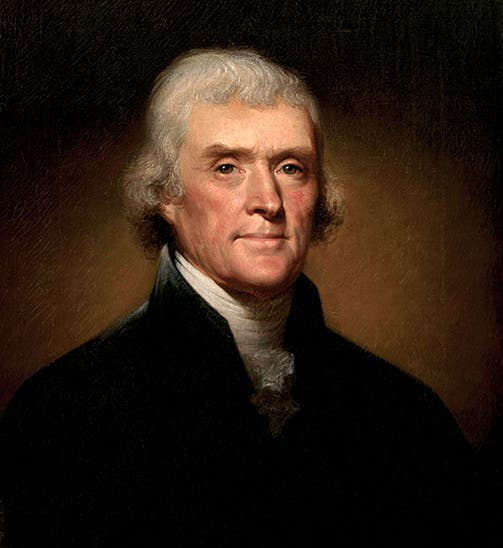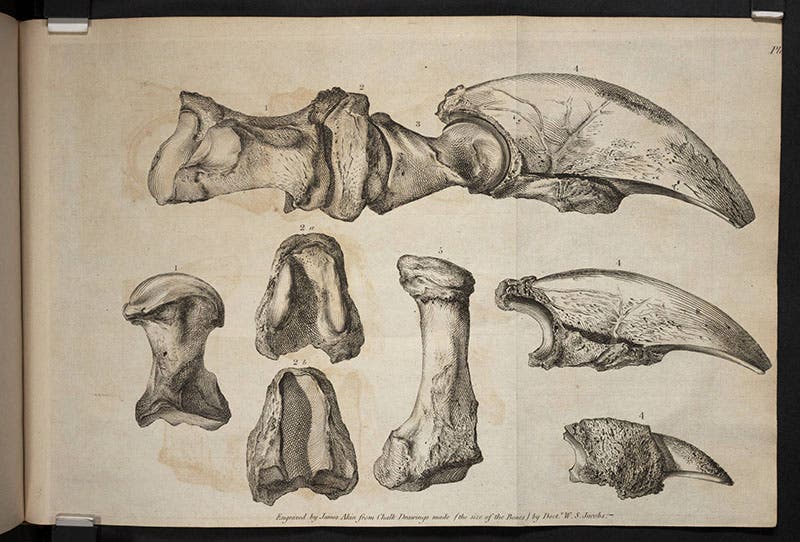Scientist of the Day - Thomas Jefferson
Thomas Jefferson, the third President of the United States, was born Apr. 13, 1743. In 1781, in response to a query from a French diplomat asking for information about the natural resources of the colonies, Jefferson compiled his Notes on the State of Virginia, one of the first books on the natural and economic history of any part of the Americas. Jefferson was especially motivated by the French naturalist, Georges Louis Leclerc, Comte de Buffon, who in his Histoire naturelle (1749-1804) had maintained that the animals of the Americas were inferior to those of the Old World. Buffon blamed the inhospitable climate of the New World for our deficiencies. Jefferson took great issue with Buffon's claim, and in the Notes he compiled a long list of American animals that were bigger than continental models. Pride of place was given to the grizzly bear, the moose, the bison, and of course the mastodon, all of which were larger than similar European types. When Buffon asserted that America had not yet produced one man of genius, Jefferson replied: “In war we have produced a Washington…; in physics, a Franklin… and Mr. Rittenhouse is second to no astronomer living.” Jefferson modestly omitted himself, although he was arguably the prime genius of the lot. Jefferson had not originally intended to publish the Notes, so he says, but he revised it extensively for several years, and allowed this revision to be privately printed in Paris in 1785. Yielding to demand, he then authorized a printing for public sale, which was published in London in 1787. The Library has a second American edition, printed in Philadelphia in 1794, in the History of Science Collection.
Jefferson made many other contributions to the natural sciences in the early Republic. He encouraged and approved the Louisiana Purchase and immediately dispatched Meriwether Lewis and William Clark on the country’s first government-sponsored scientific expedition in 1803. Jefferson was an active member of the American Philosophical Society (APS) in Philadelphia and served as its president for eighteen years, beginning in 1797 and continuing through his terms as U.S. Vice-President and President. He even made an important paleontological find of his own, when he learned of and then acquired some fossil bones found in western Virginia, which he perceived as the remains of sort of prehistoric clawed animal, and which he named Megalonyx (“giant claw”; we now know that Megalonyx was not a carnivore but a large ground sloth). Jefferson published a paper on the discovery in the Transactions of the APS (1799), and his friend, Caspar Wistar, wrote a technical paper about Megalonyx that was published as well. Wistar’s paper was accompanied by two plates; the most graphic one, reproduced here, showed the claws; the other, which depicted a femur, was drawn for publication by Titian Peale, son of the noted Philadelphia artist and museum director Charles Willson Peale. Titian died in 1798, before his illustration was published, but in 1800, another member of the Peale family, Rembrandt Peale, painted a portrait of Jefferson that, in the opinion of many, is the finest portrait of Jefferson that we have (first image). It is part of the White House Collection.
Dr. William B. Ashworth, Jr., Consultant for the History of Science, Linda Hall Library and Associate Professor emeritus, Department of History, University of Missouri-Kansas City. Comments or corrections are welcome; please direct to ashworthw@umkc.edu.







